| Back to Back Issues Page |
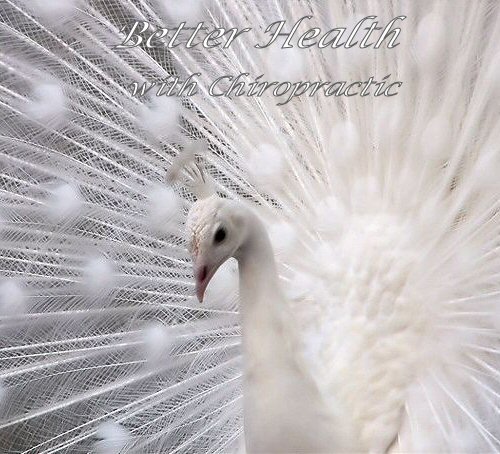 |
|
CHIROPRACTIC HELP #46: Lower backs and ankles April 28, 2016 |
DearLower backs and anklesGreetings once again from Chiropractic Help. This is our 46th newsletter; you can view the back issues at the bottom of any page at the site.This month we compare and contrast the treatment of lower backs and ankles, looking at some of the reasons why the former has become enormously expensive with failures common, whilst the latter is rather more successful. 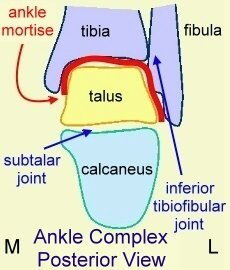 Lower backs and ankles have much in common; they can both be extremely disabling and painful. They both have bony structures that can fracture, bridging ligaments that rupture, and with supporting muscles that are very tender when overly stressed. They are also extremely intricate organs with a multiplicity of complex joints that enable us to bend and twist, run and jump with ease; when all is well. When all is not well, it's man down. Just ask Tiger Woods. The treatment of them both is also similar in many ways, but there is one major difference which is the real focus of this newsletter, leading to the lumbar spine being one of the leading expenses in medical insurance; more of that later. For stresses and strains, Medicine treats both backs and ankles with anti inflammatory medication with some success. Screws and plates are used when there are fractures or chronic instability. Chiropractic too treats stresses and strains with ice and various modalities, manipulations, exercise and muscle strengthening techniques, also with some success. For acute fractures we refer them to orthopaedic surgeons. There is, of course, one huge difference; the lower back has large vulnerable nerve roots, primarily of the sciatic and femoral nerves that can be damaged by the injury, and exacerbated by both medical and chiropractic treatment, though by the latter is usually of a more temporary nature. Lower backs and anklesSo what's the big deal and why write a newsletter comparing lower backs and ankles, you are probably asking, yawning, and thinking of hitting the delete button? When the ankle is seriously injured, the structure can be completely immobilised with a cast of some sort, originally made of plaster of paris, but increasingly with a rigid boot allowing some movement; for about six to eight weeks whilst the ligaments and bones heal. And generally, that is fairly successfully achieved. But here's the deal; you can't immobilise the lumbar spine in that way; a corset may be used with some success, but in very large measure it's up to the patient to be his or her own corset, and limit movement. Therein lies the problem; once the pain is significantly lessened, whether with medication or chiropractic treatment, we start bending and twisting, and sitting again all too soon. And before long there's often a relapse. Intervertebral disc
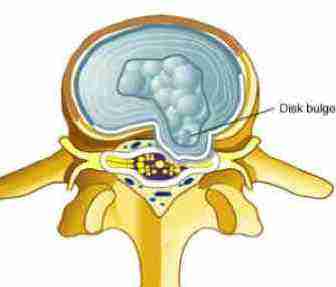 The intervertebral disc is a complex, ligament-like structure, consisting of a ring-like washer called the annulus, and an inner gel known as the nucleus. In the so-called slipped disc, a part of the inner gel ruptures through the annulus, threatening the nerve roots, and even the spinal cord that lies close behind. Here the analogy of lower backs and ankles ends. There is no comparable structure in the foot. Bear with me, I'm getting to my point and it's an important point that, if you can grasp will save you a heap of pain, and a pot of cash; whether you consult surgeons or chiropractors. That bulging disc often puts the patient into a very strange posture, known as an antalgia; you may be bent to the side looking like the leaning Tower of Pisa. You are in extreme pain, and very anxious; and in fact this antalgia if not carefully managed leads on to serious nerve impingement with pain, numbness and weakness down the leg. 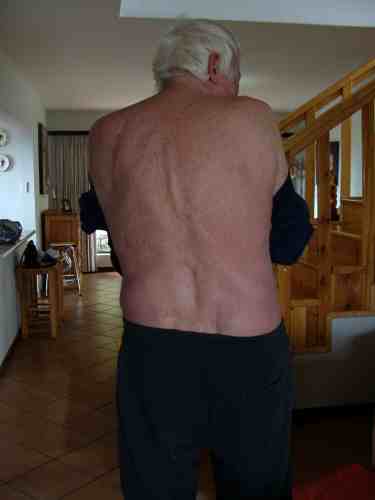 Notice how this man is twisted to the left; the slipped disc in the lower back is a very painful event. This newsletter is not primarily about lower backs, nor injured ankles. It's about the self-discipline that needs to be applied if you have a slipped disc, whether you go to the surgeon or chiropractor. In a surprisingly short time, a skillfully applied chiropractic adjustment can reduce that disc and completely relieve the pain; sometimes within minutes, but more usually a few days. Likewise, the severe pain down the leg can be quickly relieved with surgical intervention; again in days. As an aside, chiropractors also treat many patients with severe leg pain, but the relief tends to be rather slower; they come to us either because they don't want a knife in the back, or can't afford surgery. And now, finally, my point
And now, finally, my point; it's worth repeating. Unlike in the ankle it's difficult to immobilise the lower back once that slipped disc has been reduced. But the damaged tissue is not unlike that in the ankle and still takes six to eight weeks to heal. You have to be your own corset; only you can slow down, and perhaps stop long enough for the annulus to heal. If you don't, a relapse will occur, often worse than the original tear as the nucleus bulges even deeper into the surrounding fibres, and possibly rupturing into the foramen or spinal canal. If you start to bend too soon, sit, or sneeze before the healing has occurred, you're in for a relapse. Self employed folk are particularly at risk; their businesses simply stop whilst they are man down. You have little pain after treatment and often find yourself back in the deep end within days or weeks, before adequate healing has occurred. 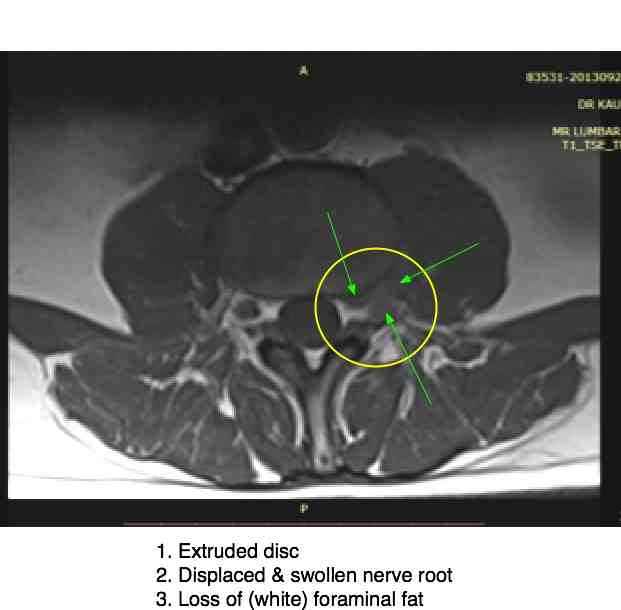 I speak with some authority on this subject, having treated thousands of cases over thirty-five years, and being personally the subject of just such an injury. Above is the MRI of my own back. Comparison of right and left reveals the cause of the severe pain down the front of my left thigh, and inner lower leg. I injured my lower back originally whilst lifting a beehive; after chiropractic treatment from a colleague (my daughter), Pisa quickly returned to her usual upright stance and all too soon I was again treating patients demanding to see me. Several small relapses occurred, more treatment and again returning to hard physical work, and sitting, long before it was sensible. I should have known better; those who will not hear must feel, and I felt. Then came the severe extrusion of the disc into the intervertebral foramen, and in fact a sequestered fragment into the spinal canal itself whilst turning a very heavy patient on the chiropractic bench. I was fortunate not to lose bladder control. You can read the boring details if you want at femoral nerve damage. But that's not my point. What is important to understand is that lower backs, unlike ankles, can not easily be immobilised; we ourselves have to put the brake on. Don't bend
After a lower back injury, don't bend but go down on one knee when retrieving something from the floor; and obviously don't lift anything even slightly heavy. Sit much less
This is probably the most difficult; sit much less and choose your chairs carefully. That probably means staying out of the car as much as possible, and lying on the back seat whilst going to the chiropractor, or whoever you are consulting. Sitting, the pressure in the disc goes up 12 times; if you start sitting for too long before adequate healing, it's a major cause of a relapse. Imagine if you put 24 bars in your car tyre instead of 2. Dejeurine's triad
Dejeurine's triad of coughing, sneezing and bearing down on the toilet are also causes of a relapse. If you're a smoker, pretty please stop, or at least reduce your smoking drastically; every day is a good day to quit, and especially this one. If you're allergic to your canary or cat, give it away. If you suffer from constipation, start having prunes for breakfast, a large salad for lunch and your greens for dinner. It's important, and should continue for the full six to eight weeks. The alternative is too ghastly to contemplate! Just ask Tiger. Lower back exercises
Rehabilitation of lower backs and ankles is vital after a serious injury, and in fact should probably continue for the rest of your life. It's now a weak point and future episodes lie in wait. I myself, after skilled chiropractic help, recovered completely, am again treating patients, digging in the garden, lifting gliders and last week harvested 130 bottles of honey from my hives. But I NEVER miss my lower back exercises; they are done every single morning before arising. Do them on your bed. Don't laugh, but also do them before sexual intercourse too; you've no idea how often patients ruefully admit that after sex, without proper foreplay that should include lower back exercises, they ended up with severe low back pain. I'm treating one right now, which brings it to mind. Short walks and swimming
Short walks and swimming after lower back and ankle injuries are always a good idea. But not too far and not too soon; if you stumble on an uneven paving stone you're in for trouble. Wear the corset initially whilst walking. I recently received a letter from a reader at this site who went for surgery, felt so good that the next day he walked five miles; and couldn't understand that within a week had severe pain down his leg again. The surgeon must have been tearing his hair out. You yourself have to apply the brake after a serious lower back and to a lesser extent ankle injury. In short, don't bend, sit much less, try not to sneeze, eat your prunes and do your exercises. Then you have at least a reasonable chance of avoiding the diagnosis of FBS, or failed back surgery. Failed back chiropractic occurs too, often for similar reasons. Economic burden
Injuries to the lower back are imposing an increasing, substantial financial burden on society. The direct costs include treatment, scans and hospitalisations. Indirect costs are substantial too; loss of productivity, lost earnings, absenteeism and early retirement from important jobs. Add to that the intangible costs of the sheer misery of chronic lower back pain. It really is possible to avoid this bed of woe; in large measure it's determined by your own acceptance that the handbrake is in your hand, and only you can apply it. Faithfully doing your exercises is vital if you want to get back to a normal life after a serious lower back injury. In short, the cost of lower back and ankle injuries is often due to an inability by any doctor to protect your back whilst healing is occurring; it's up to you to do it. No one else can. DietFor that disk to heal all the necessary nutrients for collagen repair, plenty of oxygen and gentle movement are needed. Researchers at Harvard Medical School found that a chicken bones extract was more effective than medication for some serious forms of arthritis; I would suggest that it would help provide the nutrients for injured cartilage too. Vitamin C from citrus and peppers is also important for the repair of that disc. Tiger Woods
I don't know the details of Tiger Woods' back, but I do know he could afford the very best care in the world. Despite that the former number one finds himself ranked at 499 in the world. Last year he apparently had two back surgeries. If it happened to Tiger, it can happen to you. Kaempferol There is increasing interest in a bioflavonoid called kaempferol; the only connection to lower backs and ankles is that it prevents cancer in the whole body. It's found in many fruits and vegetables; those eating a broad diet of many coloured foods have no need for concern. They are getting sufficient kaempferol. It's particularly rich in your greens like broccoli, in the onion family and fruits like apples and berries. It's not difficult to enjoy kaempferol and cancer prevention three times a day. An apple for breakfast, green salad for lunch and an onion or leek based stew for supper would provide ample kaempferol; it's one of the reasons that those enjoying five to ten coloured foods per day have a 35 percent lower all cause of death. As with lower backs and ankles, we ourselves have to take responsibility for our own health, and that of our family, if we want to escape these miseries. Henry Fielding
"It is a trite but true observation that I hope that the example of my own slipped disc may act as forcibly on you as the precept that prevention is better than a cure. It is possible to recover almost completely from serious injuries and illness, but you do have to apply your mind. Henry Fielding's most famous book is called A history of Tom Jones, a Foundling. It has nothing to do with lower backs and ankles. I've just downloaded it for free onto my Kindle. Whilst you're about it, download Stones in my Clog by a rather less famous author, Bernard Preston; it will cost you the princely sum of $2.99.
Till next month, then... yours in better health.
Barrie Lewis DC and Bernard Preston DC! PS. Feel free to forward this to family and friends, your chiropractor and even your medical doctor! You can support this site by purchasing one of Bernard Preston's chiropractic books. Dirt cheap on your Kindle, tablet or smartphone.
|
| Back to Back Issues Page |